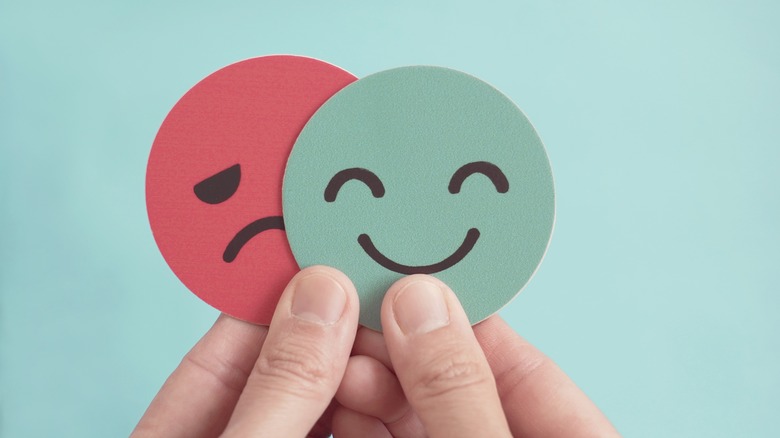Here's Why Manic Depressive Was Renamed To Bipolar Disorder
Throughout the years, psychology has proven to be an evolutionary field, moving from the early days of Freud's psychoanalysis to a more modern and comprehensive approach to human behavior. As with many fields, as new information is gained and research provides a better understanding, the terminology and definitions used in the field of psychology can and do evolve.
For many years, the term "manic depressive illness" was used as a diagnosis. More specifically, it referred to a state of behavior characterized by periods where the individual went through extreme mood shifts or swings without an identifiable cause or reason. It also included lapses in judgment and periods of erratic or psychotic behavior, as explained by the Alvarado Parkway Institute. However, it became more commonly used as a blanket term to describe a host of different mental illnesses that seemed to be associated with or have a direct effect on the individual's mood, such as shifts between depression and irritability.
Why did manic depression become bipolar disorder?
Bipolar disorder was first described by the ancient Greeks and Romans with the words "mania" and "melancholia," which were used in opposition to describe states of extreme excitement or agitation and intense depressive episodes (via Alvarado Parkway Institute).
Though a number of terms had been used since to describe this mental state of being, it wasn't until Emil Kraepelin coined the term "manic-depressive insanity" to describe the illness that it had a definitive name (via PsychCentral).
However, the term "manic" eventually became associated with maniacs, creating stereotypes of individuals with mental illness being homicidal maniacs or engaging in maniacal behaviors (via Alvarado Parkway Institute). In 1980, the third edition of the "Diagnostic and Statistical Manual of Mental Disorders" reclassified the mood disorder as bipolar disorder. The change was said to help individuals avoid the negative stigma associated with the word (via Healthline). Since this revision, the term "bipolar" has been widely accepted and adopted in the fields of psychology and psychiatry.
What is bipolar disorder?
"Bipolar disorder" is a term currently used to describe four categories of mood-shifting mental illnesses. These are bipolar 1, bipolar 2, cyclothymic disorder, and unspecified bipolar disorder (via WebMD).
Bipolar 1 is characterized by having one or more episodes of mania for at least seven days, with or without a depressive episode. Manic episodes often involve energetic behaviors like rapid speech and fidgeting, and for some, they can involve risk-taking or dangerous behaviors (via Healthline).
Bipolar 2 is characterized by depressive episodes that are experienced alongside episodes of hypomania. Hypomania is similar to mania in that the individual often experiences more energy and an elevated mood. However, the experiences are not as intense and typically only last for a few days.
Cyclothymic disorder involves a person shifting between manic and depressive states for a period of at least two years. The person may sometimes experience periods of normal mood, however, they do not last for more than eight weeks (via WebMD).
Unspecified bipolar disorder is used to describe mood disorders that otherwise do not fit into another category. People with this diagnosis have periods of elevated mood, but the pattern does not match that of any other diagnosis.
If you or someone you know needs help with mental health, please contact the Crisis Text Line by texting HOME to 741741, call the National Alliance on Mental Illness helpline at 1-800-950-NAMI (6264), or visit the National Institute of Mental Health website.



